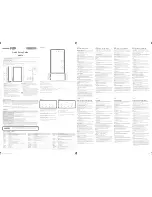
________________________________________________________________________
XDI200 Manual Version 0.1
- Page 39 -
©2017 Electromotive, Inc.
References to DFU #2 in the software will correspond to the 2 secondary spark plug coils (coil
outputs A2 and B2), and will fire the
trailing spark plugs
on rotors 1 and 2, respectively.
Typically, rotaries work well with about 7-15 degrees of split between the leading and trailing
ignition under light load. Under full load, the engines generally make best power with closer to
zero degrees of split. A rotary will run on just the leading or trailing ignition, but a power loss will
occur. Keep this in mind when trying to diagnose ignition wiring problems.
Rotor 1
Leading: Coil Channel A1
Trailing: Coil Channel A2
Coil Channel A1 and A2 are split by the value in the Dual Plug Timing Split.
Rotor 2
Leading: Coil Channel B1
Trailing: Coil Channel B2
Coil Channel B1 and B2 are split by the value in the Dual Plug Timing Split.
4.5.11
Dual Plug Engines
4 & 6 cylinder only
For dual plug engines, there are two spark plugs per cylinder. Although it may seem that
you should connect both towers of one coil to the two spark plugs of one cylinder, this is NOT the
case. Doing so would require one coil to fire two spark plugs that are on the compression stroke,
which would have a very negative effect on spark energy. Instead, the coils must be wired so
that each cylinder will have two coils for its two spark plugs. Refer to the example of the 6-
cylinder Porsche Dual Plug engine to see how the wiring should be done.
Since most dual plug cylinder heads have a hemispherical design, the spark for both plugs
on an individual cylinder should occur at the same instant for optimum flame-front propagation.
However, with non-hemispherical dual plug heads, it may be desired to experiment with
staggering the spark timing from one plug to the next. To do this, the Dual Plug Timing Split
Table can be used. The values entered into this table represent the timing split (in degrees)
between the two spark plugs on a particular cylinder. When this is done, the flame front will begin
at different areas of the cylinder at different times, resulting in an uneven flame propagation.
Consequently, it is recommended that most dual plug applications NOT use the Dual Plug Timing
Split.
4.6 Spark Plug Wire Selection
The
XDI200
outputs an extremely high-energy charge for the ignition coils. Resistor
(carbon) core wires work best with this charging method, since they absorb electrical noise
generated by the coil firing events. Use 8mm or larger RFI and EMI suppression wire with GM
boots. We recommend using a carbon core-style suppression wire with a resistance of 3,000 to
5,000 ohms per foot.
SOLID CORE WIRES SHOULD NEVER BE USED
. Do not be misled by
spark plug wire manufacturers claiming to give you a “power increase” from their wire. The
bottom line is that with our charging method, different spark plug wires simply do not make a
difference in terms of spark energy. However, there is a huge difference in noise generated by
different spark plug wire types (solid core wires generate a very high amount of noise with our
system).
Quoted from Magnecor’s Website:
“What is not generally understood (or is ignored) is that the potential 45,000 plus volts (with alternating
current characteristics) from the ignition coil does not flow through the entire the length of fine wire used
for a spiral conductor like the 1 volt DC voltage from a test ohmmeter, but flows in a magnetic field
















































